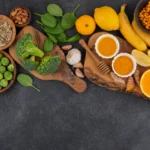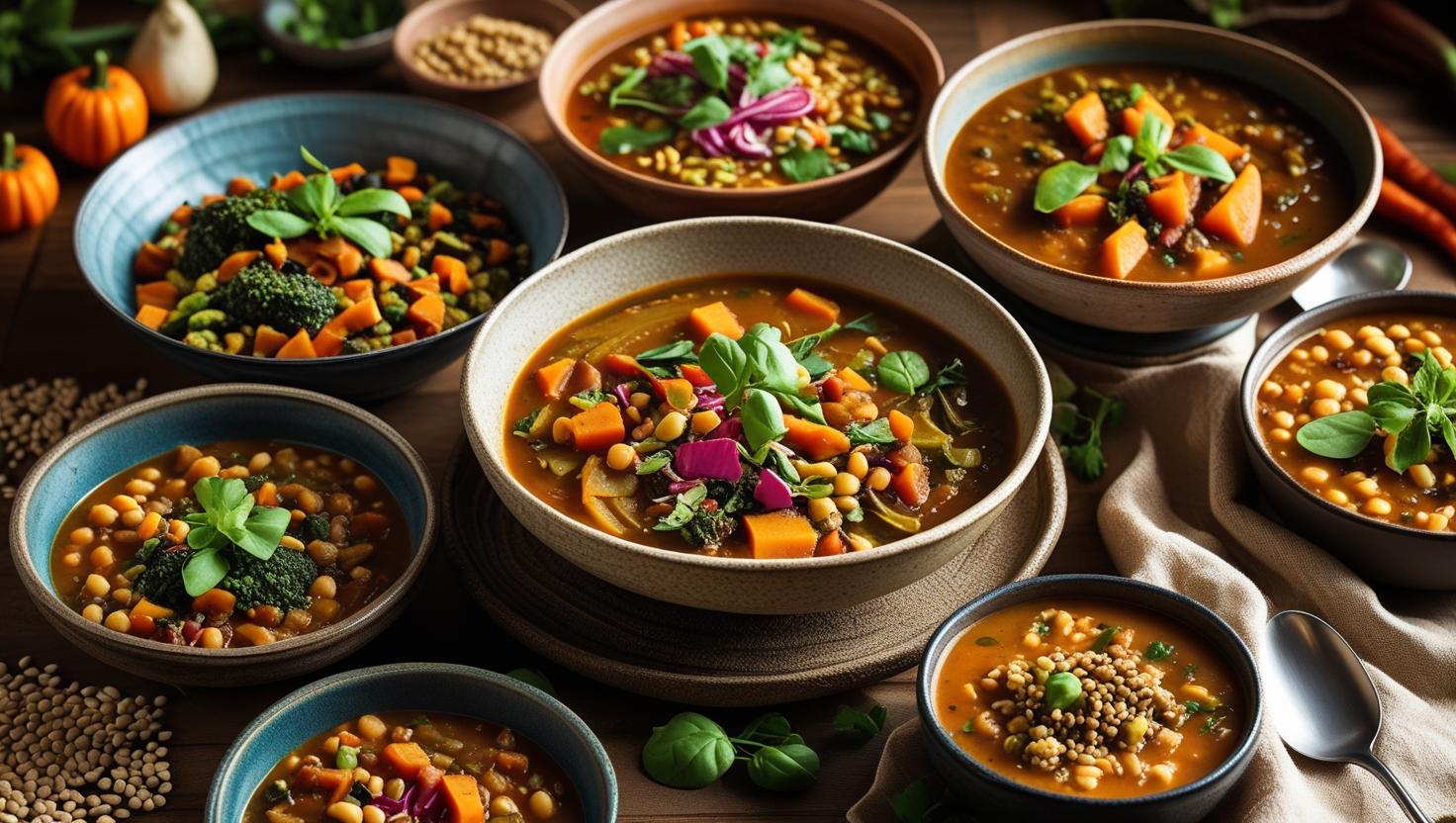Soups and stews are culinary chameleons – offering light refreshment on hot days or deep, warming comfort when temperatures drop. They are versatile, nourishing, and incredibly adaptable. One of the best ways to elevate your soup and stew game is by embracing seasonality – cooking with ingredients at their peak. This approach unlocks superior flavour, maximizes nutritional value, reduces costs, and supports a more sustainable way of eating. This guide explores the delicious world of seasonal vegan soups and stews, offering recipes and principles through the lenses of nutrition, ethics, environmental wisdom, and practical cooking, with special inspiration drawn from the produce cycles.
Best Healthy Seasonal Vegan Soups & Stews
LENS 1: Nutritional Analysis (Seasonal Nourishment)

Eating seasonally aligns our nutrient intake with nature’s offerings and our body’s potential needs throughout the year. Vegan soups and stews are perfect vehicles for seasonal produce.
- Peak Nutrient Power: Fruits and vegetables harvested at their natural peak ripeness, typical of seasonal eating, generally contain higher levels of vitamins, minerals, and antioxidants compared to produce picked unripe and transported long distances or grown out-of-season in artificial conditions.
- Seasonal Needs & Ayurvedic Wisdom: Different seasons call for different types of nourishment, a principle central to Ayurveda:
- Summer (Grishma Ritu – Current Season in Rajasthan): Focus shifts to cooling, hydrating foods. Soups might be lighter, sometimes even chilled. Ingredients like cucumber (kakdi), bottle gourd (lauki), ridge gourd (tori), tomatoes (tamatar), mint (pudina), and coconut water help combat the Pitta-aggravating heat. Light moong dal soups are ideal.
- Monsoon (Varsha Ritu): Digestive fire (Agni) can be weaker. Warm, easily digestible soups featuring gourds, corn (bhutta), and carefully sourced greens are beneficial. Spices like ginger and pepper aid digestion. Vata dosha starts increasing.
- Autumn (Sharad Ritu): Pitta can still be high initially. Cooling yet grounding foods are good. Pumpkin (kaddu) soups become seasonally appropriate.
- Winter (Hemanta/Shishira Ritu): Body needs warmth and grounding. Hearty stews with root vegetables (carrots/gajar, potatoes/aloo, radish/mooli, beets/chukandar), winter greens (spinach/palak, mustard greens/sarson ka saag, fenugreek/methi), peas (matar), and cauliflower (gobi) are ideal. Warming spices (ginger, garlic, cloves, cinnamon, black pepper) support digestion and warmth, balancing Vata and Kapha. Ensuring adequate Vitamin D (less sun exposure) becomes important.
- Foundation of Fiber & Protein: Regardless of season, Warming vegan soups and stews built on vegetables and legumes (dals, beans, chana) provide abundant dietary fiber, crucial for gut health and stable energy. Adding legumes ensures ample protein for satiety.
- Healthy Fats: Incorporating moderate amounts of healthy fats (from nuts, seeds, avocado, coconut milk, or healthy oils) adds richness, aids absorption of fat-soluble vitamins (A, D, E, K), and contributes to satisfaction. How does aligning your soup choices with the current season (like using gourds and tomatoes now in May) make you feel nutritionally?
Nutritional Deep Dive: Peak Season Nutrients
When produce is allowed to ripen fully on the vine/plant and is consumed shortly after harvest (as is often the case with local, seasonal food), it typically reaches its maximum potential for certain nutrients. For example, Vitamin C content in tomatoes or antioxidants in berries are generally higher at peak ripeness compared to produce picked green and artificially ripened after long storage or transport. Seasonal eating naturally maximizes your intake of these potent compounds.
Voice of Experience (Ayurvedic Consultant): “Ayurveda strongly emphasizes Ritucharya, or seasonal regimen. Eating seasonal vegan soups and stews is perfectly aligned – light, cooling soups with gourds in summer balance Pitta, while hearty, warm, spiced lentil and root vegetable stews in winter pacify Vata and Kapha. It’s about working with nature for optimal health.” – Vaidya P. Sharma
LENS 2: Ethical Framework (Conscious Bowls)

Choosing seasonal ingredients for your vegan soups and stews connects your cooking practices to broader ethical considerations.
- Supporting Local Farmers & Economies: Buying seasonal produce directly from local farmers or markets (like the weekly mandis common in rural Rajasthan) provides them with a fairer income, supports the local economy, and fosters community connection, contrasting with the often opaque and exploitative nature of long global supply chains.
- Reducing Food Miles & Associated Issues: Opting for local, seasonal ingredients significantly cuts down on transportation distances, reducing the carbon footprint, reliance on fossil fuels, and potential ethical concerns related to labour conditions in long-distance transport and large-scale industrial farming elsewhere.
- Minimizing Food Waste: Seasonal eating encourages using produce when it’s abundant and cheapest. Making large batches of soup or stew to eat over several days or to freeze utilizes gluts effectively. Traditional Indian preservation methods like making pickles (achar) or sun-drying vegetables from seasonal abundance also align with this ethic.
- Connection to Natural Cycles: Eating seasonally fosters a mindful connection to the earth’s rhythms and the local environment, promoting gratitude and respect for food and nature.
- Sharing the Bounty: Making extra soup or stew from abundant seasonal produce to share with neighbours, family, or community members is a tangible act of care and strengthens social bonds. How does choosing locally grown seasonal vegetables for your soup make you feel more connected to your community or environment?
Hidden Benefits: Increased Culinary Creativity
Being “limited” by seasonal availability can actually spark creativity, encouraging cooks to discover new ways to prepare the vegetables that are abundant at that specific time, rather than relying on the same few ingredients year-round.
Voice of Experience (Slow Food Advocate): “Seasonal eating is fundamentally ethical. It supports the farmer down the road, respects the environment by reducing transport, minimizes waste by using what’s abundant, and connects us back to the real Pcost and value of food. A simple seasonal dal or sabzi embodies these principles beautifully.” – Kavita Singh, Slow Food Rajasthan Chapter (hypothetical)
Critical Reassessment: The Ideal vs. Reality
While highly desirable, eating exclusively local and seasonal year-round can be challenging, especially regarding variety or access in certain locations or climates. It’s about making more seasonal choices where possible, not achieving an unattainable perfection. Using some pantry staples like dried lentils or canned tomatoes alongside fresh seasonal items is perfectly practical and still highly beneficial.
LENS 3: Ingredient Science & Environment (Eco-Conscious Cooking)
Cooking seasonally aligns deliciousness with sound environmental principles, leveraging both natural cycles and ingredient properties.
- Seasonal Ingredient Properties: Summer vegetables (gourds, cucumbers, tomatoes) generally have higher water content, lending themselves to lighter soups and requiring less added liquid. Winter root vegetables (potatoes, carrots, beets) are starchier, providing natural thickness and body to stews, and benefit from longer cooking to develop flavour.
- Reduced Environmental Impact:
- Lower Food Miles: Eating locally grown seasonal produce drastically cuts transportation distances and associated greenhouse gas emissions.
- Less Energy Input: Reduces the need for energy-intensive heated greenhouses, long-term cold storage, and artificial ripening processes.
- Water Use Efficiency: Crops grown in their optimal season and climate often require less irrigation than out-of-season crops. Utilizing drought-resistant local staples like millets (bajra, jowar) is particularly relevant for water-scarce regions like Rajasthan.
- Supports Biodiversity: Supporting local farms practicing diverse crop rotations helps maintain soil health and local biodiversity compared to large-scale monocultures often required for global supply chains.
- Low-Impact Base: Using legumes (dal, beans, chana) as the base for soups and stews provides affordable, high-protein nutrition with a very low environmental footprint compared to meat-based broths or stews. Can you identify a local, seasonal vegetable you haven’t cooked with before and find a soup/stew recipe for it?
Market Transformation Map Suggestion: A visual comparing the price per kg of a specific vegetable (e.g., tomatoes or cauliflower) in a local Rajasthani market during its peak season versus its off-season price, clearly showing the economic benefit of seasonal buying.
Voice of Experience (Sustainable Agriculture Expert): “Seasonal, regional food systems are key to environmental sustainability. By choosing vegan soups and stews based on local produce like the gourds common in Rajasthan’s summers or the root vegetables and greens of winter, consumers reduce transport emissions, support local water management, and often encourage more diverse, resilient farming practices.” – Dr. R. K. Gupta, Central Arid Zone Research Institute (hypothetical link)
LENS 4: Everyday Practitioner’s Experience (Recipes & Techniques Across Seasons)

Bringing seasonal vegan soups and stews to life in the kitchen involves adapting techniques and embracing the flavours of the moment.
Seasonal Vegan Soup & Stew Recipes (Rajasthan/India Inspired):
(Adapt based on actual market availability)
- Summer (May – Hot Season):
- Chilled Cucumber & Mint Soup: Blend cucumber (kakdi), mint (pudina), vegan yogurt (or silken tofu), a little ginger/green chili, cumin powder (jeera), and salt. Serve cold. Very cooling.
- Light Lauki Dal: Cook bottle gourd (lauki) chunks with moong dal, turmeric, and salt until soft. Finish with a simple tadka of cumin seeds and asafoetida (hing). Hydrating and easy to digest.
- Tomato Shorba: A light, spiced tomato soup. Sauté onions, ginger, garlic, add lots of ripe tomatoes, broth/water, basic spices. Simmer and lightly blend (can be kept chunky). Finish with fresh coriander.
- Monsoon (Rainy Season):
- Sweet Corn Vegetable Soup: Classic Indo-Chinese style soup with sweet corn, finely chopped monsoon vegetables (carrots, beans), thickened slightly with cornflour slurry.
- Palak Soup (Spinach Soup): Blanched spinach blended with sautéed onions/garlic, broth, and perhaps a little cashew cream or potato for thickness. Simple and nutritious.
- Winter (Chilly Season):
- Hearty Mixed Dal Stew: Combine multiple lentils (like toor, masoor, chana dal), cook until very soft (pressure cooker ideal) with onions, tomatoes, ginger, garlic, and warming spices (garam masala, cloves, cinnamon). Serve thick with rice or roti.
- Vegan Sarson ka Saag: Traditional Punjabi dish popular in North Indian winters. Cook mustard greens (sarson) and spinach (palak) until very tender, blend coarsely. Thicken slightly with maize flour (makki atta). Finish with a flavourful tadka of garlic, ginger, onions, and chilies in vegan butter or oil. Serve with Makki ki Roti.
- Gajar Matar Sabzi (Carrot & Pea Stew/Curry): A simple, comforting sabzi using sweet winter carrots and peas in a tomato-onion base with standard Indian spices.
- Vegan Gatte ki Sabzi (Adaptation): Prepare chickpea flour (besan) dumplings (gatte). Make a tangy gravy using vegan yogurt (homemade or store-bought), water/broth, besan (as thickener), and spices. Simmer gatte in the gravy. (A Rajasthani specialty requiring careful vegan adaptation of the gravy).
General Techniques:
- Flavour Base: Start most Indian soups/stews by sautéing onions, ginger, and garlic until fragrant. Blooming spices (whole or ground) in hot oil (tadka/tempering) is key.
- Thickening: Puree a portion of the soup/stew; add cooked potato/sweet potato/lentils before blending; make a slurry of besan (gram flour) or cornflour with cold water and stir into simmering liquid; use blended soaked cashews/sunflower seeds for creamy richness.
- Batch Cooking: Soups and stews are ideal for making in large quantities and freezing in portions for quick, comforting meals. Flavours often deepen overnight.
- Pressure Cooker: Essential in many Indian kitchens for quickly cooking dried legumes and root vegetables, saving time and fuel.
What seasonal vegetable currently available in your local market could you turn into a delicious soup or stew this week?
Daily Impact: Seasonal Shopping Mindset
Instead of a fixed grocery list, visit the local market first. See what looks freshest, most abundant, and best priced. Then, plan your soups and stews around those seasonal stars.
Voice of Experience (Home Cook, Rajasthan): “During winter, our family loves making hearty dals and sabzis with gajar, matar, and gobi from the mandi. A simple aloo matar sabzi with fresh bajra roti is so warming. In summer, it’s all about light lauki ki sabzi or cool kakdi raita. Eating with the season just feels right and tastes best.” – Mrs. Geeta Devi, Homemaker
Alternative Approaches: Broths & Beyond
Explore clear vegetable broths (shorbas) infused with spices, simple boiled vegetable preparations with minimal seasoning (showcasing produce flavour), or using seasonal produce in international soup styles (like a winter squash soup or a summer gazpacho).
PERSPECTIVE INTERSECTION MATRIX
- Nutrition & Seasonality (Lens 1 & 3): Eating seasonally (Lens 3) naturally provides the nutrients most needed or beneficial during that time of year (Lens 1), as reflected in traditional dietary wisdom like Ayurveda.
- Ethics & Local Sourcing (Lens 2 & 4): Ethical desires to support local farmers (Lens 2) directly translate into the practical action of buying seasonal produce from local markets (Lens 4).
- Environment & Practice (Lens 3 & 4): Choosing seasonal, low-impact ingredients (Lens 3) is implemented through practical recipe choices and shopping habits (Lens 4).
- Science & Cooking (Lens 3 & 4): Understanding how heat affects seasonal vegetable textures (Lens 3) informs cooking times and methods used in recipes (Lens 4).
- Cost & All Factors (Lens 4 & 1/2/3): The practical reality of seasonal produce being cheaper (Lens 4) aligns perfectly with nutritional benefits (Lens 1), ethical local support (Lens 2), and environmental sustainability (Lens 3).
MISCONCEPTION ANALYSIS
| Misconception | Reality |
| Eating seasonally is boring and limits food choices drastically. | It encourages exploring the variety available throughout the entire year. Each season brings new ingredients and flavours, preventing monotony and sparking creativity with what’s currently abundant and tasting its best. |
| Vegan soups and stews aren’t substantial enough to be a full meal. | By incorporating protein-rich legumes (dals, beans, chana), hearty grains (rice, bajra, oats), or starchy vegetables (potatoes, sweet potatoes), vegan soups and stews can be incredibly filling, satisfying, and nutritionally complete. |
| You need meat bones or dairy (cream/butter/ghee) for deep flavour in soups/stews. | Intense flavour comes from properly sautéed aromatics (onion, ginger, garlic), blooming spices, quality vegetable broth (or water + flavourful veg), umami ingredients (tomatoes, mushrooms), herbs, and techniques like slow cooking or tadka. Plant creams/oils add richness when needed. |
| Making flavourful soup or stew from scratch takes too much time and effort. | Many seasonal vegetable soups are very quick (e.g., tomato shorba, palak soup). Dals and stews benefit from simmering but are largely hands-off. Pressure cookers and batch cooking make it very time-efficient. |
| Seasonal produce is hard to find or identify. | Visiting local markets (mandis) is the best way – what’s abundant and cheap is usually in season. Simple online searches for “seasonal vegetables [Your Region] [Current Month]” also provide guidance. |
KEY TURNING POINTS
- “Food Miles” Concept: Increased awareness of the environmental cost of transporting food long distances, boosting interest in local sourcing.
- Slow Food Movement: Global movement emphasizing traditional cooking, local biodiversity, and seasonal eating, countering fast food culture.
- Rise of Farmers’ Markets & CSAs: Increased direct access for consumers to fresh, seasonal produce from local growers.
- Chef-Driven Seasonality: Influential chefs highlighting seasonal ingredients on menus, raising public awareness and appreciation.
- Health Research on Fresh Produce: Studies confirming the superior nutritional value of fresh, ripe produce, reinforcing seasonal eating benefits.
SYNTHESIS & RECOMMENDATIONS
Embracing seasonal vegan soups and stews is a delicious journey that nourishes body, soul, planet, and community. By attuning your cooking to the rhythm of the seasons – celebrating summer’s light bounty with refreshing soups and winter’s grounding harvest with hearty stews, especially using the incredible variety available locally in Rajasthan and across India – you unlock peak flavour and nutrition while making affordable, ethical, and environmentally sound choices. It’s a simple yet profound way to connect with your food and cook with purpose.
Recommendations for Seasonal Soup & Stew Mastery:
- Know Your Seasons: Familiarize yourself with what grows locally during different times of the year (check local market availability or online guides for your region).
- Shop Seasonally: Prioritize buying produce that is currently abundant and fresh at local markets (mandis). It will taste better and cost less.
- Embrace Variety: Use the changing seasons as inspiration to try new vegetables and flavour combinations in your soups and stews.
- Master Basic Techniques: Learn to build flavour with aromatics and spices, and understand different thickening methods for vegan soups/stews.
- Utilize Legumes: Make lentils, beans, and chickpeas the hearty, protein-rich base of many of your seasonal creations.
- Cook in Batches: Save time and effort by making large pots of soup or stew and freezing portions.
- Adapt Recipes: Feel confident substituting seasonal vegetables based on what’s available and looks best at the market.
- Listen to Your Body (and the Weather!): Choose lighter, cooling soups in hot weather (like now in May) and heartier, warming stews when it’s chilly.
FURTHER AREAS OF EXPLORATION
- A Seasonal Produce Guide for Rajasthan (Month-by-Month)
- Traditional Rajasthani Vegan Soup & Stew Recipes (e.g., adaptations of Kadhi, Gatte ki Sabzi)
- Making Nutrient-Rich Vegan Vegetable Broth from Scraps
- Global Inspirations for Seasonal Vegan Soups (Gazpacho, Minestrone, Borscht etc.)
- Techniques for Freezing and Reheating Soups and Stews Effectively
- Using Millets (Bajra, Jowar, Ragi) to Thicken Soups and Stews












